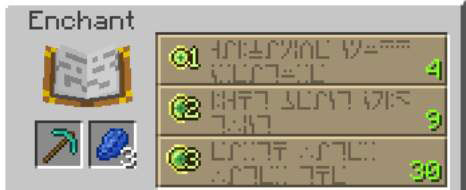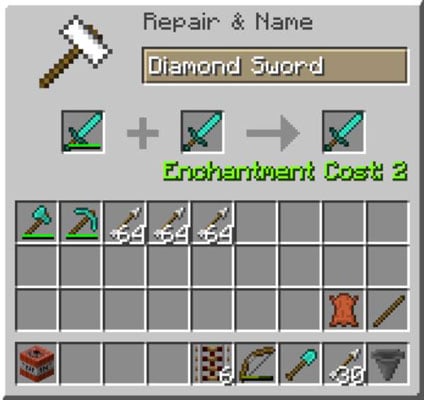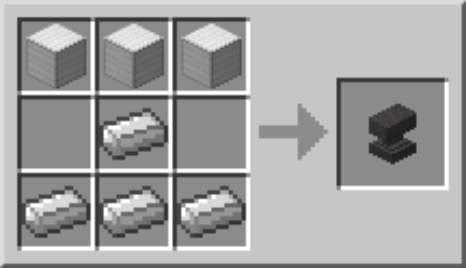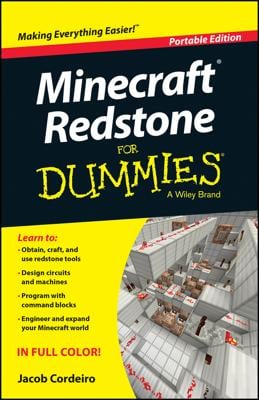To achieve a lower enchantment, you should place a block, such as a piece of carpet or a torch, between the enchantment table and a bookcase. Unfortunately, you don’t fully control which enchantment is available.
Steps for enchanting a tool or armor
After constructing an enchantment table, here’s how to enchant a tool or armor:-
Open up your enchanting screen by right-clicking the enchantment table.
The enchanting screen will show, with a place where you can place items, and three buttons.
-
Select the tool or armor or other item (like a book) to be enchanted.
Hoes, shears, and horse armor cannot be enchanted on a table.
-
Power the enchantment table with lapis lazuli.
In the latest version of Minecraft, in order to enchant things, your enchantment table must be powered with lapis lazuli. You do so by placing lapis lazuli in the second block on the enchantment table. Place the same number of lapis lazuli as you have numbers on the right.
Then you’re given three options, displaying only the Experience points required for the spell, and, by moving your mouse over the option, one of the enchantments that you are guaranteed to get, with a one, two, or three as your price. You aren’t given any indication if you will gain any other enchantments for the item you are enchanting however.
-
Choose one of the three options randomly.
The options are labeled using a special language (with characters called “runes”) but even when ciphered, the combination of runes doesn’t disclose the enchantment. The higher the level option, the higher level enchantment you will receive. To know what the item was enchanted with, mouse over the item in your inventory and the enchantment will appear under the item name.
To get around the problem of not knowing what an item will be enchanted with, many players choose to enchant a book, revealing the enchantment, and then use the book on an anvil to apply a specific enchantment to the desired item. (For a list of enchantments, see the table below.)
The one, two, and three are your cost. Choosing one means you will have to pay one experience point and one lapis lazuli. Paying three means you will have to pay three experience points and three lapis lazuli.

List of enchantments
| Enchantment | Effect | Item |
|---|---|---|
| Protection | Reduces damage | Armor |
| Fire protection | Reduces fire damage | Armor |
| Feather falling | Reduces fall damage | Boots |
| Blast protection | Reduces explosion damage | Armor |
| Thorns | Damages attacker | Armor (helmet, boots, leggings only on anvil) |
| Projectile protection | Reduces projectile damage | Armor |
| Aqua infinity | Increases underwater mining speed | Helmet |
| Respiration | Increases underwater breathing | Helmet |
| Depth strider | Increases underwater movement | Boots |
| Looting | Increases mob drops | Sword |
| Knockback | Increases the range that a mob is thrown when hit | Sword |
| Fire aspect | Sets items on fire | Sword |
| Bane of anthropods | Increase damage to spiders, silverfish, and endermites | Sword and ax (ax only on anvil) |
| Sharpness | Increases damage | Sword and ax (ax only on anvil) |
| Smite | Increases damage to skeletons, zombies, and withers | Sword and ax (ax only on anvil) |
| Fortune | Increases block drops | Sword, shovel, ax |
| Silk touch | Mined blocks drop themselves | Pickaxe, shovel, ax, and shears (shears on anvil) |
| Efficiency | Increases mining speed | Pickaxe, shovel, ax, and shears (shears on anvil) |
| Lure | Increases rate of fish biting | Fishing pole |
| Luck of the sea | Decreases odds of junk when fishing | Fishing pole |
| Infinity | Shooting uses up no arrows | Bow |
| Punch | Increases knockback | Bow |
| Flame | Sets arrows on fire | Bow |
| Power | Increases damage | Bow |
| Unbreaking | Increases durability | Armor, sword, bow, fishing pole, axe, shovel, and pickaxe; using an anvil —shears, flint and steel, carrot on a stick, and hoe |
How to craft an anvil in Minecraft
An anvil is useful in Minecraft to repair items without breaking the enchantment. An anvil can also combine enchantments and rename items. An anvil is more complicated than a crafting table, and it requires experience points (earned by completing tasks in the game, and by killing mobs) and materials in order to repair an item.Like many of the items an anvil repairs — including tools, weapons, and armor — an anvil becomes damaged with use and lasts, on average, for only 24 uses. After you craft an anvil, it opens its own menu when you right-click it.
To repair or enchant an item, follow these steps:-
Place the item in the first slot.
-
Place the sacrifice piece in the second slot.
For enchantments, you place the enchantment book in the second slot. For other items, you place an ingredient (such as iron ingot to repair an iron sword) in the second slot.
The game calculates the cost of the repair and determines whether you have enough experience points (seen as the bottom bar below the hearts) to complete the repair. (This statement does not apply to Creative mode.) Repairing on an anvil is generally only desirable to preserve enchantments.

An anvil is one of the more expensive items to craft, because it requires more iron than a complete set of iron armor. To craft an anvil, place three blocks of iron on the top horizontal row, three iron ingots on the bottom horizontal row, and 1 iron ingot in the middle square. Then you have a total of 31 iron ingots (blocks are composed of nine iron ingots apiece).


